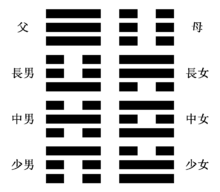Geomancy
Geomancy translates literally to "earth divination," and the term is used for methods of divination that interpret geographic features, markings on the ground, or the patterns formed by soil, rocks, or sand.[1]


Geomancy was practiced by people from all social classes. It was one of the most popular forms of divination throughout Africa and Europe, particularly during the Middle Ages and the Renaissance, although in Renaissance magic, geomancy was classified as one of the seven "forbidden arts", along with black magic, hydromancy, aeromancy, pyromancy, chiromancy (palmistry), and scapulimancy.[2]
History

The word "geomancy", from Late Greek *γεωμαντεία *geōmanteía translates literally to "earth divination";[3] it is a calque translation of the Arabic term ‛ilm al-raml, or the "science of the sand". Earlier Greek renditions of this word borrowed the Arabic word raml ("sand") directly, rendering it as rhamplion or rabolion. Other Arabic names for geomancy include khatt al-raml and darb al-raml.[4]: 14–15
Forms
Arabic geomancy
The Arabic tradition consists of sketching sixteen random lines of dots in sand. This same process survived virtually unchanged through its introduction to Europe in the medieval era, and survives to this day in various Arabic countries. Sikidy and other forms of African divination also follow techniques that have remained virtually unchanged.
African geomancy
In Africa one traditional form of geomancy consists of throwing handfuls of dirt in the air and observing how the dirt falls. It can also involve a mouse as the agent of the earth spirit. Ifá, one of the oldest forms of geomancy, originated in West Africa, and uses the same sixteen geomantic figures as in Arabic and Western geomancy with different meanings and names; the process is shortened to using only two figures.
Chinese geomancy
In China, the diviner may enter a trance and make markings on the ground that are interpreted by an associate (often a young or illiterate boy). Similar forms of geomancy include scrying involving the patterns seen in rocks or soil.
I Ching

The Chinese divination practice of the I Ching has several striking similarities to geomancy. It includes a series of binary trigrams (as opposed to tetragrams used in geomancy) that are generated at random, the resulting figures of which are taken in combination. However, the figures are not added or reorganized as in geomancy, but are instead taken to form a single hexagram. While there are 23, or eight, trigrams, there are 26, or 64, hexagrams. This yields a smaller set of resulting charts than geomancy.
Indian Vastu shastra
Vastu shastra is a traditional Indian system of architecture[5] which literally translates to "science of architecture."[6] These are texts found on the Indian subcontinent that describe principles of design, layout, measurements, ground preparation, space arrangement, and spatial geometry.[7][8] Vastu Shastras incorporate traditional Hindu and in some cases Buddhist beliefs.[9] The designs are intended to integrate architecture with nature, the relative functions of various parts of the structure, and ancient beliefs utilizing geometric patterns (yantra), symmetry, and directional alignments.[10][11]
Vastu Shastra are the textual part of Vastu Vidya, the latter being the broader knowledge about architecture and design theories from ancient India.[12] Vastu Vidya knowledge is a collection of ideas and concepts, with or without the support of layout diagrams, that are not rigid. Rather, these ideas and concepts are models for the organization of space and form within a building or collection of buildings, based on their functions in relation to each other, their usage and to the overall fabric of the Vastu.[12] Ancient Vastu Shastra principles include those for the design of Mandir (Hindu temples),[13] and the principles for the design and layout of houses, towns, cities, gardens, roads, water works, shops and other public areas.[8][14][15]
Central Asian Kumalak
Kumalak is a type of geomancy practiced in Kazakhstan, Tuva, and other parts of Central Asia. Kumalak makes use of a three by three grid, wherein a shaman will ritually place up to 41 beads. These shamans use kumalak more to connect with their ancestors and spiritual guides than to obtain information through divination. Further, shamans who use kumalak must be initiated and taught how to perform the rituals of kumalak correctly. According to them, kumalak is an ancient system of knowledge reaching back to the roots of their civilization.
Korean geomancy
In Korea, this tradition was popularized in the ninth century by the Buddhist monk Toson (Doseon). In Korea, geomancy takes the form of interpreting the topography of the land to determine future events and or the strength of a dynasty or particular family. Therefore, not only were location and land forms important, but the topography could shift causing disfavor and the need to relocate. The idea is still accepted in many South East Asian societies today, although with reduced force.[16]
Feng shui
In the 19th century, Christian missionaries in China translated feng shui as "geomancy" due to their observations of local shamans and priests manipulating the flow and direction of energy based on aesthetics, location, and position of objects and buildings. Although it stems from a distinct tradition, the term "geomancy" now commonly includes feng shui. Similarly, the introduction of a similar Indian system of aesthetics and positioning to harmonize the local energies, vastu shastra, has come under the name "geomancy". Due to the definition having changed over time (along with the recognized definition of the suffix -mancy), "geomancy" can cover any spiritual, metaphysical, or pseudoscientific practice that is related to the Earth. In recent times the term has been applied to a wide range of other occult and fringe activities, including Earth mysteries and the introduction of ley lines and Bau-Biologie.
In fantasy literature
In some fantasy literature, especially that which deals with the four classic Greek elements (air, water, fire, earth), geomancy refers to magic that controls earth (and sometimes metal and crystals).
See also
| Part of a series on |
| Artes Prohibitae |
|---|
- Dowsing – Pseudoscientific attempts to locate underground objects
- Earth mysteries – Range of beliefs regarding earthly supernatural phenomena
- Ley line – Straight alignments between historic structures and landmarks
- Tiang Seri – System of geomancy in south-east Asia
- Vashtu – Architecture and design-related texts of India
References
- “Geomancy.” Merriam-Webster.com Dictionary, Merriam-Webster, https://www.merriam-webster.com/dictionary/geomancy . Accessed 26 Jan. 2023.
- Johannes Hartlieb (Munich, 1456) The Book of All Forbidden Arts; quoted in Láng, p. 124.
- Harper, Douglas. "geomancy". Online Etymology Dictionary. Retrieved 2018-10-25.
- Skinner, Stephen (1980). Terrestrial Astrology: Divination by Geomancy. London: Routeledge & Kegan Paul Ltd.
- Quack, Johannes (2012). Disenchanting India: Organized Rationalism and Criticism of Religion in India. Oxford University Press. p. 119. ISBN 9780199812608. Retrieved 17 August 2015.
- Narlikar, Jayant V. (2009). "Astronomy, pseudoscience and rational thinking". In Percy, John; Pasachoff, Jay (eds.). Teaching and Learning Astronomy: Effective Strategies for Educators Worldwide. Cambridge University Press. p. 165.
- "GOLDEN PRINCIPLES OF VASTU SHASTRA Vastukarta". vastukarta.com. Archived from the original on 2016-04-05. Retrieved 2016-05-08.
- Acharya P.K. (1946), An Encyclopedia of Hindu Architecture, Oxford University Press
- Kumar, Vijaya (2002). Vastushastra. New Dawn/Sterling. p. 5. ISBN 978-81-207-2199-9.
- Stella Kramrisch (1976), The Hindu Temple Volume 1 & 2, ISBN 81-208-0223-3
- Vibhuti Sachdev, Giles Tillotson (2004). Building Jaipur: The Making of an Indian City. pp. 155–160. ISBN 978-1861891372.
- Vibhuti Sachdev, Giles Tillotson (2004). Building Jaipur: The Making of an Indian City. p. 147. ISBN 978-1861891372.
- George Michell (1988), The Hindu Temple: An Introduction to Its Meaning and Forms, University of Chicago Press, ISBN 978-0226532301, pp 21–22
- GD Vasudev (2001), Vastu, Motilal Banarsidas, ISBN 81-208-1605-6, pp 74–92
- Sherri Silverman (2007), Vastu: Transcendental Home Design in Harmony with Nature, Gibbs Smith, Utah, ISBN 978-1423601326
- Peter H. Lee and Wm. Theodore de Bary eds, Sources of Korean Tradition Volume 1, New York: Columbia University Press, 1997.
External links
- Medieval Geomancy, Elizabeth Bennet's web site
- Collegium Geomanticum, John Michael Greer's web site
- Ron Eglash's web site (Ethnomathematician)
- Wim van Binsbergen's web site (African studies professor)
- Astrological Geomancy at Renaissance Astrology
- Astrogem Astrological Geomancy
- A Potted History of Geomancy, article by Richard Creightmore